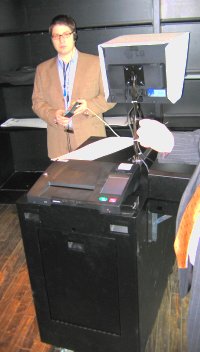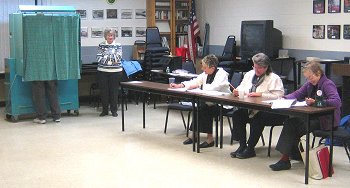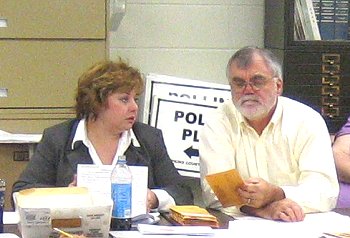- By Dan Veaner
- News
 Print
Print 
The new voting machine showing the optical scanner above the ballot box, with handicapped voting devices on the other side. Voting machine picture courtesy of the Tompkins County Board of Elections
"Each polling site that we can eliminate by consolidating saves us purchasing one of these units," says Tompkins County Democrat Election Commissioner Stephen M. DeWitt. "The other side of the equation is finding help that is comfortable in showing people how to use these machines when they come to the polling sites. You have to train all these people on this unit."
Sheldon noted that the Crash Fire Rescue (CFR) building at the Ithaca Tompkins Regional Airport is small and inconvenient for voters, but that the Oakcrest Road fire station is too small to consolidate districts into. Further he said that the Board of Elections is worried that they won't be able to use the Bill Cooke dealership as a polling place any more, because its fate is uncertain in the wake of the sale of the dealership. He also spoke of the possibility of merging the Central Fire Station and Town Hall polling places into the Town Hall.
The Board of Elections has chosen the Sequoia Imagecast Ballot Marker and Precinct Ballot Counter for Tompkins County voters. Because HAVA requires voting machines that can be used by people with a variety of handicaps, the county will have to buy at least one machine that has the capability to vote using a large screen, audio tactile devices where voters can listen to the choices on headphones, or sip and puff and similar devices.
One of the benefits of this particular machine is that it has the handicapped devices on one side, and an optical scanner that both reads paper ballots and deposits them into a ballot box on the other. DeWitt says that he hopes to have a screen between the two halves so that a handicapped voter can be voting on one side while other voters place ballots they have already filled out in a privacy booth into the scanner on the other side. This dual use device will mean that most polling places will only need one machine.

This Central Fire Station polling place may be consolidated
into the one at Lansing Town Hall
DeWitt says that consolidating polling places probably won't make voting take more time, even with only one scanner. The reason is that multiple 'privacy booths' will be provided where the paper ballots are actually marked. "You're still going to have the check-in table," he says. "If you have two districts you will have two check-in tables. It's going to be very similar there. In that polling room you will have several privacy booths where people can mark their ballots. They would go to the scanner, and the scanner would take the ballot in probably about a second or less, and deposit it right into the ballot box."
The approximately $11,500 price tag for these dual use devices is the reason the Board of Elections hopes to consolidate polling places. With 50 polling places currently in Tompkins County, reducing the total by five would save county taxpayers $57,500, not including training and stipends for election inspectors, or supplies such as printed ballots that the county's current lever-pull machines don't use.
In fact the Tompkins County Legislature voted unanimously on February 8th to take $41,345.34 from contingency funds to pay the required five percent match to acquire 45 of the new machines along with support equipment needed. Federal funds provided to New York State HAVA, would make up the remaining $981,244. That puts pressure on the Board of Elections to reduce polling places by at least five locations conty-wide.
But Town Board members were concerned that consolidating polling places in the sprawling town would mean Lansing voters could be disenfranchised because they would have farther to travel to vote than they already do in the sprawling town. Councilman Bud Shattuck said it would make more sense to consolidate Ithaca polling places, some of which he said are only ten blocks apart. "That's a hardship," he said. "When I mentioned it to (Republican Election Commissioner) Elizabeth Cree I said, 'Why don't you consolidate the city polling places? Some of them are within ten blocks of each other'. She said it's really hard for the people in the city to consolidate their districts. Some Lansing people are driving ten miles to a polling place out here, and it's hard to walk."

Tompkins County Election Commissioners Elizabeth W.
Cree (R) and Stephen M. DeWitt
"I'm not against them consolidating the districts," said Lansing Deputy Supervisor Connie Wilcox. "But it seems like they need to change the district boundaries. Some of the people on Asbury Road go to Cooke's or the CFR building to vote. It does seem it's a long way for a lot of these people to go, and I think sometimes they just don't go because it's out of the way."
Redistricting is tied to the US Census, and the next one isn't until 2010. That means that if polling places are consolidated now, it will be three years before redistricting could make a difference. Changing the boundaries of a voting district means considering population density as well as geography. "Election law prevents us from redrawing the boundaries of any election districts between now and 2011," DeWitt says.
Wilcox noted that people on Peruville Road who live close to the Town Hall have to go all the way to the North Lansing fire station to vote. "So do the people on the East side of Conlon Road," said councilman Matt Besemer. "They have to drive right by the Town Hall to go to North Lansing."
DeWitt says that in the 2008 election only handicapped voters will use the new machines, with everyone else using the old ones. But in 2009 the transition will be completed. He says that a few machines without the handicapped devices -- at a cost of about $7,200 each -- will be purchased for crowded polling places such as Newfield, but that the dual purpose machines will be able to handle most polling places in the county. He said the county will probably purchase a couple of spare machines of each kind for emergencies.
Sheldon noted that the county is looking for solutions to replace the CFR and Cooke polling locations. He said that it is early in the process, and at this point he wanted to get a sense of how the Town Board would react to consolidation of polling places. Cost, availability of election inspectors, and voter disenfranchise because of inconvenient and distant polling places will mean a political balancing act for town and county officials alike. But come what may, the federal deadlines will mean that we will all be voting on paper ballots with optical scanners counting the vote one year from now.
----
v4i7



